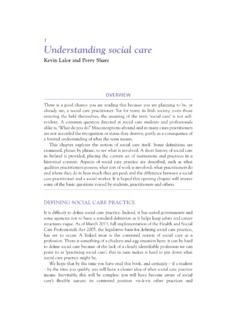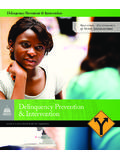Transcription of Education and Interagency Collaboration: A Lifeline for ...
1 3300 Whitehaven St. NW, Suite 5000, Washington, DC. 2005 Amber Farn, Ed Jill Adams, 3300 Whitehaven Street, , Suite 500 Washington, DC 20057 Georgetown University McCourt School of Public Policy Center for Juvenile justice Reform Education and Interagency collaboration : A Lifeline for justice -Involved Youth August 2016 Education AND Interagency collaboration 2 Acknowledgements Kathleen Sande, Michelle Maike, Michael Umpierre and Shay Bilchik also edited and provided guidance on the development of this document.
2 Recommended Citation Farn, A. & Adams, J. (2016). Education and Interagency collaboration : A Lifeline for justice -involved youth. Washington, DC: Center for Juvenile justice Reform, Georgetown University McCourt School of Public Policy. Available from . Education AND Interagency collaboration 3 Education and Interagency collaboration : A Lifeline for justice -Involved Youth Introduction ..4 The Effect of Education on Delinquency and Recidivism ..5 Barriers to Successful Education Attainment ..7 Recent Federal Guidance and Other Efforts to Improve Education .
3 8 The Washington State Education Advocate Washington EA Program Outcomes and References ..18 Education AND Interagency collaboration 4 Education and Interagency collaboration : A Lifeline for justice -Involved Youth Introduction On a given day, over 54,000 juvenile offenders are held in residential placement facilities (Office of Juvenile justice and Delinquency Prevention [OJJDP], 2015), and about one-third of these incarcerated youth are identified as needing special Education support (Council of State Governments [CSG] justice Center, 2015, p.)
4 1). It is particularly important that these at-risk youth receive high-quality Education services in order to make successful transitions from adolescence to adulthood (Leone & Weinberg, 2012). Education not only plays a significant role in facilitating moral, social, and psychological development, but also has important implications for a youth s long-term life experiences and well-being, including employment, income, and health. Unfortunately, youth involved in the juvenile justice system experience a plethora of challenges to receiving a quality Education .
5 While many studies have indicated that schooling provides a reliable pathway for delinquent youth to become healthy, productive members of their communities (Lee & Villagrana, 2015), system-involved youth often do not have access to the same high-quality educational opportunities as their non-delinquent counterparts and tend to struggle in academic settings. Research has overwhelmingly demonstrated the correlation between youth s justice system involvement and educational outcomes; poor school performance is a significant indicator of delinquency, and delinquency is a strong predictor of poor school performance (Ramirez & Harris, 2010).
6 Pettit and Western (2004) found that high school dropouts are about three to four times more likely to be imprisoned than high school graduates; approximately ten percent of white males and 60 percent of black males who drop out of school in the United States are expected to face incarceration at some point in their lives. In terms of recidivism, Beck and Shipley (1989) studied more than 16,000 prisoners from 11 states and found that the rate of re-offense decreased as offenders Education level increased.
7 The study showed that the recidivism rate was approximately 62 percent for individuals with an eighth grade Education or less, 57 percent for individuals with high school diplomas, and 52 percent for individuals with some college Education . Although studies have shown that youth who succeed in school while incarcerated are less likely to recidivate, most youth do not earn a GED or graduate from high school while in custody. A 2005 Juvenile justice Education Enhancement Program study that analyzed cases of over 10,000 delinquent youth released from facilities in Florida found that only 7% of the youth had earned a high school diploma or GED before re-entering the community (as cited in Blomberg, Bales, Mann, Piquero, & Berk, 2011).
8 These findings align with the results of a 2015 CSG justice Center survey of state juvenile correctional agencies in all 50 states. The survey asked these state agencies to report on the educational and vocational services provided to incarcerated youth; the collection, analysis and reporting of student outcome data; and what they did to ensure that youth Education AND Interagency collaboration 5 received services after release from incarceration. Key findings from the survey indicated that a majority of incarcerated youth had reading and math skills significantly below their grade level, and were suspended, expelled, or had dropped out before their confinement (CSG justice Center, 2015).
9 Moreover, only 18% of states provided vocational services similar to those available in the community, such as work-based learning opportunities, vocational certification programs, and career and technical Education courses (CSG justice Center, 2015, ). As demonstrated in these studies, the correlation between delinquency and Education is predictable. Entry into the juvenile justice system is often associated with factors that inhibit educational achievement, such as poverty, lack of adult supervision, truancy, exposure to trauma and criminal behavior, behavioral and mental health issues, and many others.
10 Juvenile justice involvement, such as attending court hearings during school hours, can disrupt students school experience. Deeper penetration into the justice system can exacerbate this disruption, as incarcerated youth often do not have access to high-quality Education programming within facilities. Furthermore, during the re-entry process, youth often encounter many barriers to reintegrating into school and obtaining academic credits or vocational skills. It is therefore imperative that policymakers, educators, and child-serving agencies work collaboratively to address the unique educational needs of youth at risk of entering, or involved in, the juvenile justice system.







